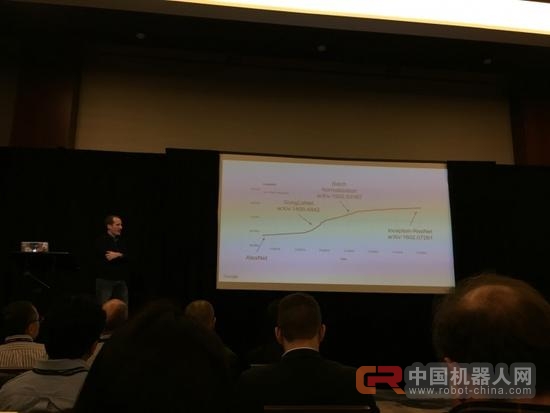 In machine translation, the introduction of machine learning in 2014 also made qualitative progress in machine translation, but it is still relatively untenable to reach human standards...
In machine translation, the introduction of machine learning in 2014 also made qualitative progress in machine translation, but it is still relatively untenable to reach human standards...  (Looking at the list on the keynote, and contributing to Google's machine translation, there are a lot of Chinese.) The histogram is the difference in the quality of human translation, neural network translation, and PBMT translation.
(Looking at the list on the keynote, and contributing to Google's machine translation, there are a lot of Chinese.) The histogram is the difference in the quality of human translation, neural network translation, and PBMT translation.  Vanhoucke believes that machine learning research is easier than ever, there are more open source tools and models, more web tutorials (he himself started online courses at Udacity), and the GPU and high-performance computing hardware thresholds have also become lower There are more researchers than ever before.
Vanhoucke believes that machine learning research is easier than ever, there are more open source tools and models, more web tutorials (he himself started online courses at Udacity), and the GPU and high-performance computing hardware thresholds have also become lower There are more researchers than ever before.  In the field of image recognition, in addition to the improvement of the underlying technology, Google has applied image recognition technology to the medical field to help doctors diagnose the condition and achieved some results.
In the field of image recognition, in addition to the improvement of the underlying technology, Google has applied image recognition technology to the medical field to help doctors diagnose the condition and achieved some results. 
 But he also said that image recognition is now far from the point of "succes," and that 40% of decisions based on image monitoring are made. The result is very bad.
But he also said that image recognition is now far from the point of "succes," and that 40% of decisions based on image monitoring are made. The result is very bad.  Next is the part of the robot. Vanhoucke is a major in electrical engineering. The main work in Google Brain is robotics. He first stressed the point that a lot of people have different perceptions: Current robotics research has little to do with deep learning. He did a demonstration and dropped the pen on the ground, saying that if the robot's task was to grab the pen, then it caught and couldn't catch it, and there was no difference in the robot's movement from the outside. Therefore, we cannot get any rules from it).
Next is the part of the robot. Vanhoucke is a major in electrical engineering. The main work in Google Brain is robotics. He first stressed the point that a lot of people have different perceptions: Current robotics research has little to do with deep learning. He did a demonstration and dropped the pen on the ground, saying that if the robot's task was to grab the pen, then it caught and couldn't catch it, and there was no difference in the robot's movement from the outside. Therefore, we cannot get any rules from it).  The machine grabs a specific object and it is possible to follow it. Grabbing an unknown object cannot solve it. (Vanhoucke broadcasts a robot wrestling highlights video, saying that in the past he thought these robots were wrestling and laughing, but after he started doing robotics projects, he couldn't laugh at this picture anymore. It's really hard to study robot crawling. , but he is very enjoyable.) The fewer image recognition techniques involved, the better the robustness of the machine and the ability to deal with more complex objects. When subsequent listeners asked about the database of objects, Vanhoucke said they (Google) did not want to create such a knowledge map.
The machine grabs a specific object and it is possible to follow it. Grabbing an unknown object cannot solve it. (Vanhoucke broadcasts a robot wrestling highlights video, saying that in the past he thought these robots were wrestling and laughing, but after he started doing robotics projects, he couldn't laugh at this picture anymore. It's really hard to study robot crawling. , but he is very enjoyable.) The fewer image recognition techniques involved, the better the robustness of the machine and the ability to deal with more complex objects. When subsequent listeners asked about the database of objects, Vanhoucke said they (Google) did not want to create such a knowledge map.  The introduction of reinforcement learning may be helpful for the study of robots, provided that there is a reference model that can generate a large number of samples. The final conclusion:
The introduction of reinforcement learning may be helpful for the study of robots, provided that there is a reference model that can generate a large number of samples. The final conclusion:  1. Robotics and machine learning are undergoing an interesting fusion; 2. For conventional robotics problems, there must be awareness of different answers; 3. It hits all the right difficult problems on the road to practical AI.
1. Robotics and machine learning are undergoing an interesting fusion; 2. For conventional robotics problems, there must be awareness of different answers; 3. It hits all the right difficult problems on the road to practical AI. Tail Lamp,LED Tail Lamp,LED Combination Tail Lamp
Haiyu Automotive Lamp Co., Ltd. , http://www.nbautomotivelamp.com
没有评论:
发表评论